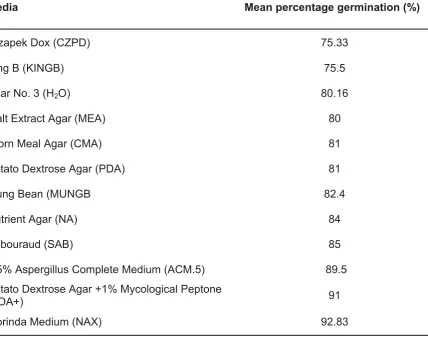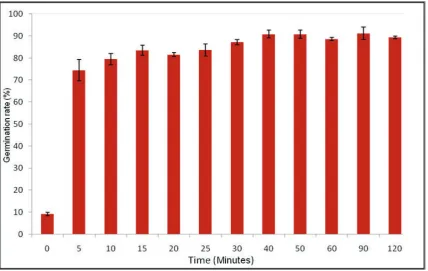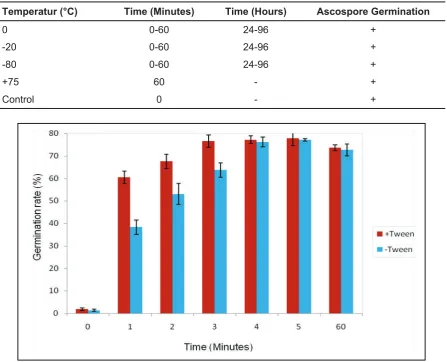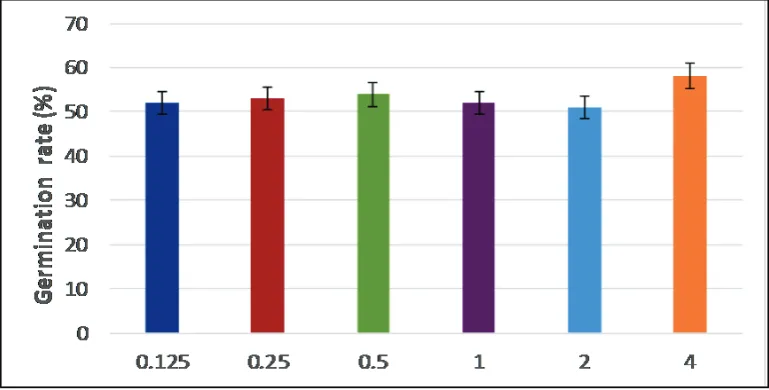Factors affecting germination of ascospores in Aspergillus fumigatus
Received: 8/8/2016 Accepted: 19/3/2017
Abstract
* Department of Basic Sciences, College of Dentistry, Hawler Medical University, Erbil, Iraq. Introduction
A. fumigatus is a saprotrophic fungus that
is involved in environmental carbon and nitrogen recycling is a ubiquitous filamentous fungus in the environment. It is abundant in soils and decomposing organic materials. It is essential that A. fumigatus
survive and flourishes in nutrient limited environments,1 and the most widespread
airborne human pathogen, accountable for approximately 90% of all invasive aspergillosis (IA) cases.2 Spores in
A. fumigatus can be produced by two
different forms of cellular reproduction, asexual reproduction (produce conidia) or sexual reproduction (produce ascospore).
Sexual reproduction involves the production of eight ascospores normally
produced in each ascus. These asci form within an ascocarp with a closed structure called cleistothecium. The species has a heterothallic breeding system, isolates of complementary mating types are necessary for sex to take place.3 Sexual
reproduction may bring about increased genetic variation, due to recombination of genes from the parents that can occur by crossing over, gene conversion, or independent segregation of centromeres, permitting a species to react to a change in the environment and evolve.4 Germination
consequently forms a first and critical stage Background and objective: Aspergillus fumigatus is the most common airborne fungal pathogen of humans. It is an opportunistic human pathogen in immunocompromised hosts. Following the recent discovery of the sexual reproductive cycle ascospores of this fungus were available and their germination was studied in the present study. This study aimed to study factors influencing germination of ascospores of A. fumigatus.
Methods: A total of 12 environmental A. fumigatus were chosen in both mating type, examined for sexual reproduction by crossing complementary mating type, following removing of cleistothecia, preparation of ascospore suspensions in 0.05% Tween 20, then heat treated to kill any remaining conidia.
Results: Ascospore germination of greater than 75% occurred at 28 °C on a wide variety of mycological media, 0.5% (ACM) was chosen for use in subsequent studies. Ascospores
did not require a heat treatment prior to germination; however, heat treatment of ascospores at 75 °C for 1 hour previous to incubation enhanced germination to 89% and also served to inactivate contaminating conidia. Ascospores also exhibited a psychrotolerance following exposure at -80 °C for 96 hours. Inoculum concentration did
not have a significant effect on germination rates between the range of 0.125×106 to4×106
ascospores ml-1 (P >0.05).
Conclusion: This study demonstrated that ascospore germination of greater than 75% occurred at 28 °C on a wide variety of mycological media. Ascospores of A. fumigatus are thermotolerant also exhibited a psychrotolerance whilst at the same time retaining viable sexual ascospores, to assess percentage germination a drop of Lactophenol Cotton Blue was added.
of the infectious process in the invasive pathogenic lifestyle of A. fumigatus; three important steps can be distinguished during spore germination, namely activation, isotropic growth, and polarized growth.5
Many aspergilli produce ascospores with relatively thick cell walls, which might again explain their superior ability to withstand adverse environmental conditions such as temperature and desiccation compared to conidia.6 In certain Aspergillus species, the
ascospores are constitutive dormancy and may require a special activation treatment involving conditions, such as high or low temperature or light or addition of a diverse of chemical agents and vitamins.7 The
thermotolerance ascospores of Aspergillus
fischeri, which is strongly related to
A. fumigatus, require an external trigger
such as heat for germination A. fischeri
was identified as a contaminant of canned strawberries; ascospores had survived heating of between 77°C and 90 °C for 30 minutes.8 Furthermore a requirement for exposure of spores to high temperature to ensure germination is especially common among saprotrophic ascomycetes, e.g., ascospores of Neurospora, Byssochlamys,
Talaromyces, and Neosartorya species
often require exposure to high temperatures between 60-90°C to trigger
germination.9 Such strong shock causing damage and changes in structure of the cell wall of these spores, which then allows germination.10 By contrast most spores of basidiomycete species, especially plant pathogens, are stimulated to germinate by exposure to low temperatures of 5 to 10° C.11 It has been suggested that a medium
contains a higher level of soluble ingredients might enhance the heat activation of ascospores of Eurotium species given the fact that this genus is xerophilic.12 In addition, self-inhibitory
substances secreted by spores in competition for space and nutrients had a significant effect.It was established that at higher inoculum concentration of conidia in
A. fumigatus such as those greater than
6 -1
Collection and isolation of A. fumigatus
isolates
The 12 isolates isolated from environmental are in storage in the School
of Biology, University of Nottingham, the UK as 10% glycerol stocks under liquid nitrogen.
Ascospore germination
In order to determine the best conditions to study ascospore germination, a series of preliminary experiments were conducted in order to identify suitable mycological media, Effect of surfactant (Tween-20 detergent), ascospore concentration, and thermotolerance of ascospores, Psychrotolerance of ascospores. Also, studies were made to identify the optimum heat shock to break the dormancy and activate the ascospore germination whilst at the same time allowing the elimination of temperature sensitive conidia
Removal of cleistothecia.
Using an Olympus SZH10 Stereo dissecting microscope and cleistothecia were picked off from the mycelium and transferred to a water agar plate. Cleistothecia were gently rolled across the water agar surface in order to keep the cleistothecium intact, using a sterilised needle tip to remove any adhering conidia. Preparation of ascospore suspensions. Mature cleistothecia were picked off from surrounding hyphae using a flame sterilised needle, observed under a Nikon-SMZ-2B dissecting microscope, taking care to avoid conidia where possible. 5-10 cleistothecia were transferred to a 4% (w/v) water agar plate
Methods
germination.13 This study aimed to detect
and gently rolled across the agar surface using a sterilised needle tip to remove any adhering conidia, Next, 20-50 µl of pH 6 sterile Tween 20 (BDH)(0.05%) was pipetted into a sterile 1.5 ml Eppendorf tube and cleistothecia ruptured against the side of the tube in this small droplet, This was made up to a final volume of 500 µl in pH 6 sterile Tween 20 (0.05%) vortex-mixing for 1 minute to release the ascospores. The concentration of the resulting ascospore suspension was determined using a Haemocytometer and were diluted as appropriate. For heat treatment of ascospore suspensions the Eppendorf tubes containing acospore suspension were inserted into holes on a polyfoam tray which was suspended over a 75 °C water bath unpublished.14
Inoculation of Petri dishes
A template and a fine tipped red permanent marker were used to outline three defined circular areas on the underside of each of two Petri dishes, typically 0.5% Aspergillus Complete Medium (ACM). The circular areas were 2.0 cm in diameter and 1.5 cm apart to ensure that spores were acting independently. The spore suspension was pipetted into each circle in a laminar air flow cabinet and spread inoculated using an inoculation loop, incubation at 28 °C for 18 hours.
Assessing germination
The American Phytopathological Society's (1943) definition of germination as being "the presence of a visible germ tube." Germination was stopped by adding a drop of magenta Lactophenol Cotton Blue Stain and placing a coverslip onto each circle.
Clumps of more than six ascospores were not counted. Germinated and ungerminated ascospores were counted, 100 ascospores were counted per circle, and as there were six replicates, 600 ascospores were counted per treatment.
Germination of ascospores of
Aspergillus fumigatus on different media
In order to select an optimal medium for ascospore germination, eleven mycological media types and Agar No. 3 as control were inoculated with six replicates for each media. Spore concentration was calculated as 0.55×106 ascospores ml-1. The media
used in this study were: 0.5% Aspergillus Complete Medium (ACM), Agar No. 3 (H2O), Corn Meal Agar (CMA, Oxoid),
Czapek Dox Agar (CZPD, Oxoid), King B Agar (KINGB), Malt Extract Agar (MEA, Oxoid), Morinda Medium (NAX), Mung Bean Agar (MUNGB), Nutrient Agar (NA, Oxoid), Potato Dextrose Agar (PDA, Oxoid), Potato Dextrose Agar (PDA, Oxoid) + 1% Mycological Peptone, and Sabouraud-2% (SAB).
Thermotolerance of ascospores of
Aspergillus fumigatus
To assess the effect of heat exposure on ascospore germination rate, Eppendorf tubes containing ascospore suspensions were placed in a water bath at 75 °C and 90 °C for periods up to 120 minutes (Table 1). Spore concentrations were calculated as 0.312×106 ascospores ml-1. Two Petri dishes were each inoculated in triplicate per time incubated at 28 °C for 18h.
Temperature (°C) Control Time (Minutes)
75 0 5 10 15 20 25 30 40 50 60 90 120
90 0 10 20 40 60 90 120
Effect of surfactant (Tween-20 d e t e r g e n t ) o n g e r m i n a t i o n o f ascospores ofA. fumigatus
To determine whether 0.05% Tween-20 detergent (BHD Chemicals, UK) used to make up acospore suspensions had an effect on ascospore germination rate. Suspensions were set up as with or without 0.05 % Tween-20 detergent where water was used as a control and heat treated at 75°C for 60 minutes Spore concentration was calculated as 1.18×106 ascospores
ml-1. Two Petri dishes each were inoculated
in triplicate and incubated at incubation at 28°C for 18 hours.
Psychrotolerance of ascospores of
Aspergillus fumigatus
To ascertain whether ascospores survive and germinate following exposure to temperatures up to -80 °C for up to 96 hours, ascospore suspensions were made up and subjected to three different temperatures for a range of time periods (Table 2). A control of 0 minute exposure
and a heat treatment at 75°C for 60
minutes in a water bath were also set up. 0°C was maintained by filling a stainless steel canister with ice into which Eppendorf
tubes were inserted, this was then left in a 5°C cold room, while -20 and -80°C fridge freezers facilitated at these temperatures.
Effect of ascospore concentration (‘population effect’) on germination of ascospores of Aspergillus fumigatus
To assess whether the level of ascospore concentration exerts an effect on the germination rate of A. fumigatus, six different concentrations were made up starting with a master concentration of
4×106 ascospores ml-1 which was
heat treated at 75°C for 60 minutes, concentrations from 0.125×106, 0.25×106, 0.5×106 1×10,6 2×106, 4×106 ascospores per mlincubation at 28 °C for 18 hours. Statistical Analysis: The statistics software (SPSS, version 21) for Macintosh (Mac OS X version 10.6.8) was used for data analysis.
Table 2: Exposure temperature and time of ascospore suspensions to cold treatment.
Temperature (°C) Time (Minutes) Time (Hours)
-80 1 2 3 4 5 60 24 96
-20 1 2 3 4 5 60 24 96
0 1 2 3 4 5 60 24 96
Control 0
G e r m i n a ti o n of a s c o sp o re s o f
Aspergillus fumigatus on different media
Following incubation at 28 °C for 18 hours, mean germination of ascospores was greater than 75% on the broad range of media. Czapek Dox Agar (CZPD) was recorded as having the lowest ascospore percentage germination of 75.33 ± 2.94% (n = 600; mean ± s.e.m.) while the control, Agar No. 3 (H2O) had a germination rate
of 80.16 ± 2.05% (Table 3). Analysis of the collated results demonstrated that 0.5% Apergillus Complete Medium (ACM)
was the optimal solid medium for
ascospore germination for use in subsequent experiments in this project.
Ascospore percentage germination rate of 89.5 ± 1.38% was measured for 0.5% ACM, although Potato Dextrose Agar+ (PDA+) and Morinda Medium NAX) had values of 91.0 ± 1.78% and 92.83 ± 2.37% respectively. Additionally, 0.5% ACM was a defined medium and was specific to Aspergillus species requirements containing optimal nutrient quantities. Furthermore, there was no significant difference between the mean values of PDA+ and NAX (P >0.05). PDA+ and NAX.
Media Mean percentage germination (%)
Czapek Dox (CZPD) 75.33
King B (KINGB) 75.5
Agar No. 3 (H2O) 80.16
Malt Extract Agar (MEA) 80
Corn Meal Agar (CMA) 81
Potato Dextrose Agar (PDA) 81
Mung Bean (MUNGB 82.4
Nutrient Agar (NA) 84
Sabouraud (SAB) 85
0.5% Aspergillus Complete Medium (ACM.5) 89.5 Potato Dextrose Agar +1% Mycological Peptone
(PDA+) 91
Morinda Medium (NAX) 92.83
Table 3: Mean percentage germination (%) of an ascospore suspension inoculated onto various media and incubated at 28 °C for 18 hours with six replicates for each media (n=600).
91.16 ± 2.85% was measured at 90 minutes. Germination of ascospores without any pre-exposure was found to be highly statistically significant to the other time intervals of 5-120 minutes which were heat treated (P <0.001). Germination was not recorded at any time interval following exposure to heat treatment of 90°C for 0-120 minutes.
Figure 2: Mean percentage germination (%) of an ascospore suspension exposed to 75 °C heat treatment for 0-120 minutes and incubated at 28 °C for 18 hours with six replicates
per time interval (n=600). Data of plot symbols labeled with the same letter are not significantly different from each other (P >0.05). Error bars represent standard errors of the
mean.
Thermotolerance of ascospores of
Aspergillus fumigatus
The thermotolerance of ascospores exposed to 75°C for 0-120 minutes (Figure 2) demonstrated that ascospores without any pre-exposure had the lowest ascospore percentage germination of 9.16 ± 0.79%. At 5 minutes percentage germination of 74.5 ± 4.89% was recorded,
Effect of surfactant (Tween-20 d e t e r g e n t ) o n g e r m i n a t i o n o f ascospores ofAspergillus fumigatus
There was no statistically significant difference between mean percentage germination presence or absence of the Tween-20 detergent (P = 0.29). However, germination of ascospores at times intervals of 1 to 3 minutes (Figure 3) showed significantly higher mean germination levels in suspensions where tween was present (P <0.05). There was
no statistically significant difference between mean germination for 4 to 60 minutes either in the presence or absence of tween (P >0.05).
Psychrotolerance of ascospores of
Aspergillus fumigatus
(Table: 4) demonstrates that ascospores
exhibited psychrotolerance as they germinated after exposure to cold treatment of up to -80 °C for up to 96 hours
when incubated at 28 °C for 18 hours.
Table 4: Presence of ascospore germination following exposure to cold temperatures of -80, -20, 0 °C, exposure to +75 °C for 60 minutes, a control without treatment and time per treatment. The Petri dishes were inoculated with six replicates per time interval (n=600).
Temperatur (°C) Time (Minutes) Time (Hours) Ascospore Germination
0 0-60 24-96 +
-20 0-60 24-96 +
-80 0-60 24-96 +
+75 60 - +
Control 0 - +
Discussion
Effect of ascospore concentration (‘population effect’) on germination of ascospores of Aspergillus fumigatus
Figure 4 revealed that there was no statistically significant difference in the mean percentage of germination between the inoculum concentration range of 0.125×106 to 4×106 ascospores ml-1
(P >0.05).
ascospore contained all the essential nutrients that are needed for the early stage of germination as reserves. As
A. fumigatus is a saprotrophic fungus and
its airborne conidia are abundant in soils and compost heaps it is essential that
A. fumigatus survive and flourishes in
nutrient limited environments. This capacity to perceive carbon and nitrogen and the adaptability of the organism to utilise different compounds enables A. fumigatus
to compete against other microflora in compost and to operate as an efficient opportunistic pathogen of immuno-suppressed hosts.15 It was
realized that ascospores were thermotolerant and exposure to 75°C
stimulated germination following 5 minutes. Germination of ascospores without any pre-exposure was found to be highly statistically significant in comparison to the other treatments at different intervals that had been subjected to heating (P <0.001). Given that ascospores had germinated
without heating, this verified that
A. fumigatus ascospores do not require a
heat shock prior to germination. However, ascospores displayed a germination rate of greater than 70% at 5 minutes and greater O’Gorman et al.3 recently discovered
that A. fumigatus possesses a sexual reproductive cycle, which leads to the production of cleistothecia and ascospores
and the teleomorph Neosartorya
fumigata. This study demonstrated that
ascospores of Aspergillus fumigatus are thermotolerant. Investigations established that ascospores were stimulated to germinate following 5 minutes of exposure to a heat treatment of 75 °C, germination occurred on 0.5% ACM incubation at 28 °C for 18h. Greater than 75% ascospore germination was recorded on the wide variety of mycological media including the water control; this indicated that ascospores were undemanding of nutrient requirements. This suggested that the
Figure 4: Mean percentage of germination (%) of ascospore suspensions ranging from 0.125×106 to4×106 ascospores ml-1and incubated at 28 °C for 18h with six replicates
than 86% at 120 minutes following heat exposure. It was evident from these values that ascospores were capable of not only surviving but demonstrated high germination levels following exposure to 75°C for up to 2 hours.5 A. fumigatus is
strongly related to A. fischeri, the conidial stages of these fungi are nearly identical 8
studied thermotolerance of both conidia and ascospores of A. fischeri var. glaber. Their findings demonstrated an apparent contrast between ascospore germination of
A. fumigatus and A. fischeri. Since dormant
ascospores of A. fischeri germinated only after an external heat shock of 70°C and above. On the contrary, the heating inactivated any contaminating conidia present in A. fumigatus suspensions, and
A. fischeri conidia remained ungerminated
following heat exposure. Dormant ascospores of Talaromyces macrosporus,
Neurospora and Byssochlamys also need
a heat trigger to break dormancy and to activate germination. Several studies have investigated heat resistance of these spores that spoil food products such as fruit juice.16 The ability of T. macrosporus
ascospores to germinate following heat exposure was due to the presence of trehalose protecting cell components as glucose was released from the cell.17 There was no statistically significant difference between mean percentage germination presence or absence of the Tween-20 detergent (P = 0.29). However.germination of ascospores at times intervals of 1 to 3 minutes showed significantly higher mean germination levels in suspensions where tween was present (P <0.05). The results
of Gomez-Lopez et al.18 confirm the
importance of the concentration of surfactant Tween- 20 to use on inoculum
preparation for antifungal susceptibility testing of Aspergillus spp. Significantly higher MICs was associated with higher concentrations of Tween- 20. Moreover,
surfactant Tween -80, at 0.02% concentration was most effective for enhancement of α-amylase production in
culture media by Aspergillus niger.19
Conclusion
Competing interests
The author declares no competing interests.
A. fumigatus ascospores also proved to
be psychrotolerant as they germinated following exposure to cold treatments of 0°C, -20 °C and -80 °C for up to 96 hours. Psychrotolerant fungi can grow at low temperatures of 5°C or lower but favour more moderate temperatures. The physiological mechanisms conferring cold tolerance in fungi are comprised of increases in intracellular trehalose and polyol concentrations and unsaturated membrane lipids. Additionally, secretion of antifreeze proteins and enzymes active at low temperatures are also involved. Many cold-tolerant fungi grow in common environments, such as Penicillium and Cladosporium species growing at 4 °C and 0 °C respectively on food in fridges.20 It was verified that the germination rate in the inoculum concentration range of 0.125×106 to4×106 ascospores ml-1 did not differ significantly (P >0.05). This suggested that there was no population effect on ascospore germination whereby an increase in space due to a lower density did not improve germination rates. In contrast, a study on germination of
A. fumigatus conidia by Manavathu et al.21
proposed that high conidial densities such as those greater than 1×106 conidia ml-1 produce lower levels of germination which they suggested was a consequence of a population effect.
1. Latgé JP.Aspergillus fumigatus and Aspergillosis. Clin Microbiol Rev 1999; 12:310–50.
2. Denning DW. Invasive Aspergillosis. Clin Infect Dis 1998; 26:781–803.
3. O’Gorman CM, Fuller HT, Dyer PS. Discovery of a sexual cycle in the opportunistic fungal pathogen Aspergillus fumigatus. Nature 2009; 457:471–4. 4. Barton NH, Charlesworth B. Why sex and
recombination? Science 1998; 281:1986–90.
5. Mouchacca J. Heat tolerant fungi and applied research: Addition to the previously treated group of strictly thermotolerant species. World J Microbiol Biotechnol 2007; 23:1755–70.
6. Dijksterhuis J, Nijsse J, Hoekstra FA, Golovina EA. High viscosity and anisotropy characterise the cytoplasm of fungal dormant stress-resistant spores. Eukaryot Cell 2007; 6:157–70.
7. Coluccio AE, Rodriguez RK, Kernan MJ, Neiman AM. The yeast spore wall enables spores to survive passage through the digestive tract of Drosophila. Plos One 2008; 3: e2873.
8. McEvoy IJ, Stuart MR. Temperature tolerance of Aspergillus fischeri var. glaber in canned strawberries. Ir J Agric Res 1970; 9:59–67.
9. Beuchat L. Extraordinary heat resistance of Talaromyces flavus and Neosartorya fischeri ascospores in fruit products. J Food Sci 1986; 51: 1506_10.
10. Dijksterhuis J, Teunissen P. Dormant ascospores of Talaromyces macrosporus are activated to germinate after treatment with ultra high pressure. J Appl Microbiol 2003; 96:162–9.
11. Leach CM. Regulation of perithecium development and maturation in Pleospora herbarum by light and tempreture. Trans Br mycol Soc 1971; 57:295–315.
12. Splittstoesser D, Lammers J, Downing D, Churey J. Heat resistance of Eurotium herbariorum, a xerophilic mold. J Food Sci 1989; 54:683_5.
13. Araujo R, Rodrigues AG. Variability of germinative potential among pathogenic species
of Aspergillus. J. Clin. Microbiol 2004; 42:4335– 7.
14. Swilaiman SS. Sexual Potential and Population Biology of Fungal Aspergillus and Penicillium species, PhD thesis. University of Nottingham; 2013.
15. Rhodes JC. Aspergillus fumigatus: Growth and virulence. Med Myco 2006; 44:S77–81.
16. Dijksterhuis J, Teunissen PG. Dormant ascospores of Talaromyces macrosporus are activated to germinate after treatment with ultra high pressure. J Appl Microbiol 2004; 96:162–9. 17. Dijksterhuis J, van Driel KG, Sanders MG,
Molenaar D, Houbraken JA, Samson RA, et al. Trehalose degradation and glucose efflux precede cell ejection during germination of heat-resistant ascospores of Talaromyces macrospores. Arch Microbiol 2002; 178:1–7.
References 18. Gomez-Lopez A, Aberkane A, Petrikkou E, Mellado E, Rodriguez-Tudela J, Cuenca-Estrella M. Analysis of the Influence of Tween Concentration, Inoculum Size, Assay Medium, and Reading Time on Susceptibility Testing of Aspergillus spp. J clinic Microbiol 2005; 43:1251– 5.
19. Gupta A, Gautam N, Modi D. Optimization of a-amylase production from free and immobilized cells of Aspergillus nige. E3 J Biotechnol Pharmacol Res 2010; 1:001–8.
20. Deacon JW. Fungal Biology. 4th ed. Oxford, UK: Blackwell Publishing; 2006.





